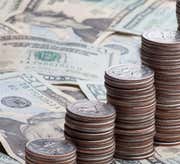By Brian Perry
While many people think of stocks as an option for portfolio growth, stocks can also be an attractive alternative for generating current income. Many stocks provide income in the form of dividends, and high dividend-paying stocks can form an important portion of a portfolio designed for safety and income. Furthermore, although an investment in stocks can potentially result in a loss of principal, stocks also offer more growth potential than many other income-generating assets. This is an important consideration because even in a portfolio focused upon safety and income, some capital appreciation is often desirable. With that in mind, this chapter of the tutorial will examine the use of stocks for generating income. (For more, see Build A Dividend Portfolio That Grows With You.)
Dividends and Stock Returns
It may surprise some readers to learn that over time, reinvested dividends provide one of the largest components of total stock market return. In fact, since 1988 the cumulative total return (including reinvested dividends) of the S&P 500 is 481%. However, if we deduct dividends and focus only on price appreciation, the cumulative return is only 258%. This shows just how important dividends are to a stock portfolio, even one focused upon growth.
High Dividend-Paying Stocks
Dividends change over time as companies become more or less profitable and as investors shift their emphasis from capital appreciation to current income. However, there are certain types of stocks that have traditionally paid large dividends. Historically, companies that are large and well-established pay higher dividends than those that are small or new. Therefore, investors are probably better off focusing on an index such as the S&P 500 for dividends as opposed to an index such as the Russell 2000.
Additionally, rapidly growing industries and companies often pay low (or no) dividends because they prefer to reinvest their profits into the business. On the other hand, slower growing industries and companies have a tendency to offer higher dividend payouts. For instance, technology and biotech companies often pay little or no dividends while utility and drug companies are well known for offering high dividend yields. (For more, check out Dividend Facts You May Not Know.)
Safe Stocks
In many instances, it may be appropriate for an investor whose primary portfolio aim is safety and income to own some stocks. In these instances though, the investor will likely wish to minimize the risk of their stock portfolio to the extent possible. One way to do this is to invest in broad-based indexes of stocks as opposed to individual stocks. Investing in this manner produces greater diversification and reduces the risk that a large holding of a single stock will perform poorly. Generally speaking, high dividends come from mature, stable companies with consistent earnings streams. These are often the same companies whose stock prices are unlikely to display exceptional volatility. Therefore, a focus upon income generating stocks can often also result in a portfolio of relatively low volatility stocks.
Investors should be aware of the relative stability of the dividends they are receiving from their stocks. While coupon payments from bonds or certificates of deposit are contractually guaranteed, dividends are paid at the discretion of the company. While many companies are committed to paying dividends at a consistent level, this can and does sometimes change. For instance, when a company experiences financial difficulty or the overall economy enters a downturn many companies choose to conserve cash in order to fortify their balance sheets. A common way in which they do this is to reduce or eliminate the dividend payout to common shareholders. Investors who depend on stock dividends to meet a portion of their living expenses should carefully calculate the impact that this could have on their finances.
Preferred Stocks
In addition to common stocks, some investors may wish to consider preferred stocks. Preferred stocks sit somewhere between common stocks and bonds in a company's capital structure. This means that they are usually considered to be less safe than corporate bonds, but safer than common stocks. Preferred stocks do not offer as much opportunity for capital appreciation as common stocks, but investors are usually compensated with higher current income. Additionally, preferred stockholders have to be paid their dividends before any leftover cash may be paid out to common shareholders, making preferred dividends more stable than common dividends.
However, it is important to note that companies often have the option of withholding preferred stock dividend payments during difficult periods. That means that income from preferred stocks is less certain than that from bonds. Furthermore, in times of financial distress, a company's preferred stock represents a more risky holding than that same company's bonds. Still, preferred stocks may represent an attractive option for investors seeking current income; as always though appropriate research and diversification are imperative if an investor is to build a secure portfolio. (For more on this topic, read A Primer On Preferred Stock.)
Conclusion
This chapter of the tutorial has examined the use of common and preferred stocks as part of a safety and income portfolio. It is important that investors are aware that both common and preferred stocks carry greater risks than many of the other investment alternatives discussed in this tutorial. However, stocks also provide greater potential for capital appreciation and may be appropriate as one component of investors' portfolios. The stocks that an investor does hold should be very well diversified and should primarily consist of large-cap companies with stable earnings and a long history of consistent dividend payments. Furthermore, an investor must carefully consider the possibility that future dividends may be reduced or eliminated; the investor can then properly evaluate what impact such a move might have on their financial position.
Safety and Income: Bonds
While many people think of stocks as an option for portfolio growth, stocks can also be an attractive alternative for generating current income. Many stocks provide income in the form of dividends, and high dividend-paying stocks can form an important portion of a portfolio designed for safety and income. Furthermore, although an investment in stocks can potentially result in a loss of principal, stocks also offer more growth potential than many other income-generating assets. This is an important consideration because even in a portfolio focused upon safety and income, some capital appreciation is often desirable. With that in mind, this chapter of the tutorial will examine the use of stocks for generating income. (For more, see Build A Dividend Portfolio That Grows With You.)
Dividends and Stock Returns
It may surprise some readers to learn that over time, reinvested dividends provide one of the largest components of total stock market return. In fact, since 1988 the cumulative total return (including reinvested dividends) of the S&P 500 is 481%. However, if we deduct dividends and focus only on price appreciation, the cumulative return is only 258%. This shows just how important dividends are to a stock portfolio, even one focused upon growth.
High Dividend-Paying Stocks
Dividends change over time as companies become more or less profitable and as investors shift their emphasis from capital appreciation to current income. However, there are certain types of stocks that have traditionally paid large dividends. Historically, companies that are large and well-established pay higher dividends than those that are small or new. Therefore, investors are probably better off focusing on an index such as the S&P 500 for dividends as opposed to an index such as the Russell 2000.
Additionally, rapidly growing industries and companies often pay low (or no) dividends because they prefer to reinvest their profits into the business. On the other hand, slower growing industries and companies have a tendency to offer higher dividend payouts. For instance, technology and biotech companies often pay little or no dividends while utility and drug companies are well known for offering high dividend yields. (For more, check out Dividend Facts You May Not Know.)
Safe Stocks
In many instances, it may be appropriate for an investor whose primary portfolio aim is safety and income to own some stocks. In these instances though, the investor will likely wish to minimize the risk of their stock portfolio to the extent possible. One way to do this is to invest in broad-based indexes of stocks as opposed to individual stocks. Investing in this manner produces greater diversification and reduces the risk that a large holding of a single stock will perform poorly. Generally speaking, high dividends come from mature, stable companies with consistent earnings streams. These are often the same companies whose stock prices are unlikely to display exceptional volatility. Therefore, a focus upon income generating stocks can often also result in a portfolio of relatively low volatility stocks.
Investors should be aware of the relative stability of the dividends they are receiving from their stocks. While coupon payments from bonds or certificates of deposit are contractually guaranteed, dividends are paid at the discretion of the company. While many companies are committed to paying dividends at a consistent level, this can and does sometimes change. For instance, when a company experiences financial difficulty or the overall economy enters a downturn many companies choose to conserve cash in order to fortify their balance sheets. A common way in which they do this is to reduce or eliminate the dividend payout to common shareholders. Investors who depend on stock dividends to meet a portion of their living expenses should carefully calculate the impact that this could have on their finances.
Preferred Stocks
In addition to common stocks, some investors may wish to consider preferred stocks. Preferred stocks sit somewhere between common stocks and bonds in a company's capital structure. This means that they are usually considered to be less safe than corporate bonds, but safer than common stocks. Preferred stocks do not offer as much opportunity for capital appreciation as common stocks, but investors are usually compensated with higher current income. Additionally, preferred stockholders have to be paid their dividends before any leftover cash may be paid out to common shareholders, making preferred dividends more stable than common dividends.
However, it is important to note that companies often have the option of withholding preferred stock dividend payments during difficult periods. That means that income from preferred stocks is less certain than that from bonds. Furthermore, in times of financial distress, a company's preferred stock represents a more risky holding than that same company's bonds. Still, preferred stocks may represent an attractive option for investors seeking current income; as always though appropriate research and diversification are imperative if an investor is to build a secure portfolio. (For more on this topic, read A Primer On Preferred Stock.)
Conclusion
This chapter of the tutorial has examined the use of common and preferred stocks as part of a safety and income portfolio. It is important that investors are aware that both common and preferred stocks carry greater risks than many of the other investment alternatives discussed in this tutorial. However, stocks also provide greater potential for capital appreciation and may be appropriate as one component of investors' portfolios. The stocks that an investor does hold should be very well diversified and should primarily consist of large-cap companies with stable earnings and a long history of consistent dividend payments. Furthermore, an investor must carefully consider the possibility that future dividends may be reduced or eliminated; the investor can then properly evaluate what impact such a move might have on their financial position.
Safety and Income: Bonds
Related Articles
-
 Investing
InvestingPut Dividends to Work in Your Portfolio
Find out how a company can put its profits directly into your hands. -
 Financial Advisor
Financial AdvisorHow mutual funds pay dividends: An overview
The process by which mutual fund dividends are calculated, distributed and reported is fairly straightforward in most cases. Here's a look. -
 Investing
InvestingIs Dividend Investing a Good Strategy?
Understanding dividends and how they generate steady income for shareholders will help you become a more informed and successful investor. -
 Investing
InvestingThe Benefits of High-Dividend Yielding Stocks
The advantages of high-dividend yielding stocks are obvious – consistent income, stocks in commonly defensive sectors and strong-performing companies. -
 Investing
InvestingValuation Of A Preferred Stock
Determining the value of a preferred stock is important for your portfolio. Learn how it's done. -
 Financial Advisor
Financial Advisor4 Reasons a Company Might Suspend Its Dividend
Learn about the four most common reasons a company may choose to suspends its dividends, including financial trouble, funding growth and unexpected expenses. -
 Investing
InvestingDividend Yield For The Downturn
High-dividend stocks make excellent bear market investments, but the payouts aren't a sure thing. -
 Investing
InvestingThe Best 8 Funds For Regular Dividend Income
Here's a list of the top mutual funds which pay regular dividends, for frequent income.



